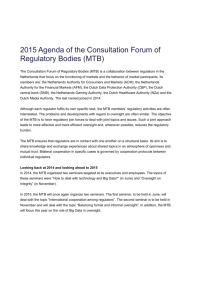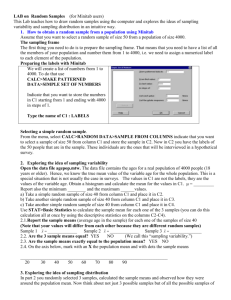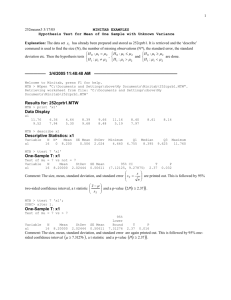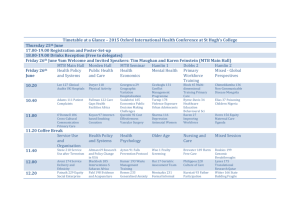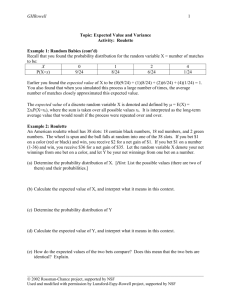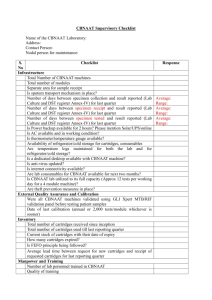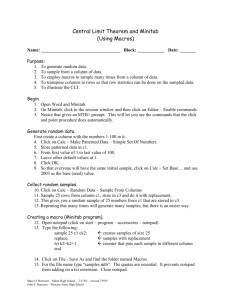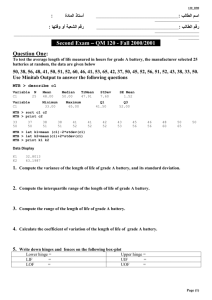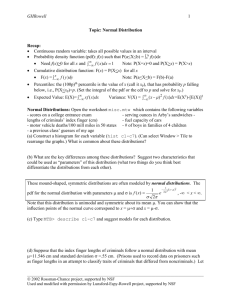Using Minitab with Student Activities on Randomness and Confidence
advertisement
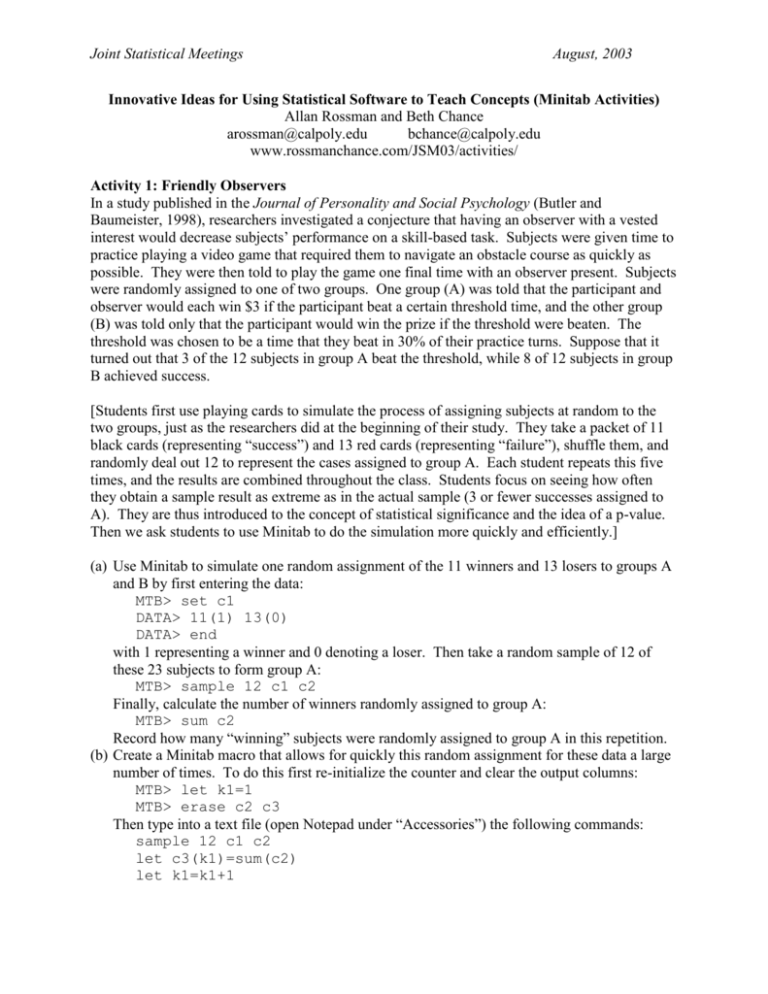
Joint Statistical Meetings August, 2003 Innovative Ideas for Using Statistical Software to Teach Concepts (Minitab Activities) Allan Rossman and Beth Chance arossman@calpoly.edu bchance@calpoly.edu www.rossmanchance.com/JSM03/activities/ Activity 1: Friendly Observers In a study published in the Journal of Personality and Social Psychology (Butler and Baumeister, 1998), researchers investigated a conjecture that having an observer with a vested interest would decrease subjects’ performance on a skill-based task. Subjects were given time to practice playing a video game that required them to navigate an obstacle course as quickly as possible. They were then told to play the game one final time with an observer present. Subjects were randomly assigned to one of two groups. One group (A) was told that the participant and observer would each win $3 if the participant beat a certain threshold time, and the other group (B) was told only that the participant would win the prize if the threshold were beaten. The threshold was chosen to be a time that they beat in 30% of their practice turns. Suppose that it turned out that 3 of the 12 subjects in group A beat the threshold, while 8 of 12 subjects in group B achieved success. [Students first use playing cards to simulate the process of assigning subjects at random to the two groups, just as the researchers did at the beginning of their study. They take a packet of 11 black cards (representing “success”) and 13 red cards (representing “failure”), shuffle them, and randomly deal out 12 to represent the cases assigned to group A. Each student repeats this five times, and the results are combined throughout the class. Students focus on seeing how often they obtain a sample result as extreme as in the actual sample (3 or fewer successes assigned to A). They are thus introduced to the concept of statistical significance and the idea of a p-value. Then we ask students to use Minitab to do the simulation more quickly and efficiently.] (a) Use Minitab to simulate one random assignment of the 11 winners and 13 losers to groups A and B by first entering the data: MTB> set c1 DATA> 11(1) 13(0) DATA> end with 1 representing a winner and 0 denoting a loser. Then take a random sample of 12 of these 23 subjects to form group A: MTB> sample 12 c1 c2 Finally, calculate the number of winners randomly assigned to group A: MTB> sum c2 Record how many “winning” subjects were randomly assigned to group A in this repetition. (b) Create a Minitab macro that allows for quickly this random assignment for these data a large number of times. To do this first re-initialize the counter and clear the output columns: MTB> let k1=1 MTB> erase c2 c3 Then type into a text file (open Notepad under “Accessories”) the following commands: sample 12 c1 c2 let c3(k1)=sum(c2) let k1=k1+1 Joint Statistical Meetings August, 2003 Save the text file as “friendly.mtb”. Then within Minitab, select File> Other Files> Run an Exec…, tell it to execute 1000 times, click on “Select file” and choose the “friendly.mtb” file that you just created. (c) When the macro has finished running, ask Minitab for a tally and a histogram of the results (remember that the results represent the number of winners randomly assigned to group A under the assumption that the observer’s incentive has no effect). Write a few sentences describing the distribution. (d) In how many of these 1000 repetitions were the results as extreme as in the researchers’ actual data? Based on this larger simulation, what is the approximate p-value of this test? Are the sample data pretty unlikely to occur by chance variation alone if the observer’s incentive had no effect? Do the sample data provide reasonably strong evidence in favor of the researchers’ conjecture? Explain. Activity 2: Random Babies Suppose that on one night at a certain hospital, four mothers (named Johnson, Miller, Smith, and Williams) give birth to baby boys. Each mother gives her child a first name alliterative to his last: Jerry Johnson, Marvin Miller, Sam Smith, and Willy Williams. As a very sick joke, the hospital staff decides to return babies to their mothers completely at random. [Students first use index cards to simulate this random process. They write one baby’s first name on each card, and they divide a sheet of paper into four areas with a mother’s last name written in each. They shuffle the cards and then deal them out randomly with one index card going to each area of the sheet. They turn over the cards to reveal which babies were randomly assigned to which mothers, and they record how many mothers got the right baby. Each student repeats this process five times, and class results are combined to produce empirical estimates of the probabilities involved. Then students list the 24 outcomes in the sample space and count the number of “matches” produced by each outcome. Assuming equal likeliness, they then calculate the theoretical probabilities for the possible number of matches. Then we ask students to turn to Minitab to do the simulation approximations, where they can generalize to large numbers of mothers/babies, in which cases enumeration of the sample space becomes intractable.] (a) Set up Minitab to conduct this simulation by entering the numbers 1, 2, 3, and 4 into c1: MTB> set c1 DATA> 1:4 DATA> end MTB> name c1 'mother' Think of the numbers in c1 as representing the mothers. Randomly sample all four numbers from c1, storing them in c2, to represent the babies randomly assigned to those mothers: MTB> sample 4 c1 c2 MTB> name c2 'baby' Then set up c3 as an indicator variable (1 if yes, 0 if no) of whether the number in c1 matches its corresponding number in c2: MTB> let c3=(c1=c2) Now count how many matches there are in this sample: MTB> sum c3 Joint Statistical Meetings August, 2003 MTB> name c3 'matches' (b) Now write a macro for conducting this simulation many more times much more efficiently by creating a text file (using Notepad) containing the following commands: sample 4 c1 c2 let c3=(c1=c2) let c4(k1)=sum(c3) let k1=k1+1 Save the text file as “matching.mtb.” In this macro, k1 will be a counter that will keep track of how many times you have simulated the process. Before running the macro, you need to initialize this counter in Minitab: MTB> let k1=1 (c) Execute the macro 1000 times (select File> Other Files> Run an Exec…), tell it to execute 1000 times, click on “Select file” and choose the “matching.mtb” file that you just created. Tally and display the number of matches in your ten simulated samples. Also calculate the mean number of matches: MTB> tally c4 MTB> hist c4 MTB> mean c4 (d) Use Minitab to produce a graph of the relative frequency of repetitions that have at most one match: MTB> let c5=(c4<2) MTB> parsum c5 c6 MTB> set c7 DATA> 1:1000 DATA> end MTB> let c8=c6/c7 MTB> name c7 'reps' c8 'relfreq' MTB> plot c8*c7 Explain what these commands do. Then comment on what this graph reveals about probability as long-term relative frequency. Also identify the value to which the relative frequency is converging. Extension: (e) Now suppose that there are eight mothers and babies. How many outcomes comprise the sample space? Since it’s unreasonable to list these outcomes, simulate 1000 repetitions of this process (again by modifying your "matching.mtb" macro appropriately), and report empirical estimates of the probability of zero, one, two, three, four, five, six, seven, and eight matches. Also report an empirical estimate of the long-term average number of matches. Activity 3: Handedness [Students determine the proportion of left-handers in class and use this sample information to produce a 95% confidence interval for the population proportion of left-handers, using the conventional (Wald) procedure. Then we introduce students to the newly proposed method of adding two successes and two failures to the sample before calculating the CI. We remind students that the confidence level reveals the long-run proportion of times that the interval will succeed in capturing the actual value of the parameter and that we can therefore use simulation to Joint Statistical Meetings August, 2003 compare different procedures by seeing which has a coverage rate closer to the nominal 95%. We ask students to use Minitab to compare the performances of these two procedures.] (a) Consider a sample size of n=10, and suppose that the population proportion is p=.2. Simulate drawing 10,000 samples from this population: MTB> random 10000 c1; SUBC> binomial 10 .2. Then use Minitab to calculate the two point estimates p̂ and p * : MTB> let c2=c1/10 MTB> let c6=(c1+2)/14 MTB> name c1 'successes' c2 'p-hat' c6 'p-star' (b) Now use Minitab to calculate a 95% confidence interval for p from each of these 10,000 simulated samples: MTB> let c3=c2-1.96*sqrt(c2*(1-c2)/10) MTB> let c4=c2+1.96*sqrt(c2*(1-c2)/10) Then count how many of the 10,000 intervals succeed in capturing the actual value of p: MTB> let c5=(c3<.2)&(c4>.2) MTB> name c3 'lower' c4 'upper' c5 'inthere?' MTB> tally c5 (c) What percentage of these 10,000 intervals succeed in capturing the actual value of p? Is this close to 95%? What does this reveal about how well the standard CI procedure performs in this situation? (d) Now use Minitab to create a 95% confidence interval from each sample based on the alternative procedure. Follow the steps for c3-c5, but use p * rather than p̂ , and put the results in c7-c9. What percentage of these 10,000 intervals succeed in capturing the actual value of p? Is this close to 95%? What does this reveal about how well the alternative CI procedure performs in this situation? (e) Repeat your analysis for four different values for n (5, 10, 20, 50) and three different values for p (.1, .2, .5). In each of these 12 cases: Simulate drawing 10,000 random samples from the appropriate binomial distribution Calculate the two point estimates of p for each sample Produce 95% confidence intervals for p from each sample, using both the conventional and alternative methods Determine the percentage of the 10,000 intervals that successfully capture the given value of p, for each of the two methods [You can use copy/paste to save yourself from having to re-type commands, but be careful to make all of the necessary adjustments for the new values of n and p each time.] (f) Create a table reporting these percentages. Write a report about the results of your simulation analysis, commenting on situations in which the conventional method does not perform well and on how well the alternative procedure performs in those situations.
